Related Research Articles
The Stonewall Brigade of the Confederate Army during the American Civil War, was a famous combat unit in United States military history. It was trained and first led by General Thomas J. "Stonewall" Jackson, a professor from Virginia Military Institute (VMI). His severe training program and ascetic standards of military discipline turned enthusiastic but raw recruits into an effective military organization, which distinguished itself from the First Battle of Bull Run in 1861 to Spotsylvania Court House in 1864. Its legacy lives on in the 116th Infantry Brigade, which bears the unofficial nickname "Stonewall Brigade," and in several living history reenactment groups.
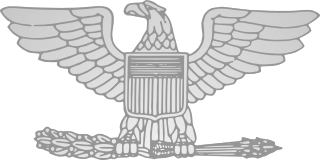
In the United States Army, Marine Corps, Air Force and Space Force, colonel is the most senior field-grade military officer rank, immediately above the rank of lieutenant colonel and just below the rank of brigadier general. Colonel is equivalent to the naval rank of captain in the other uniformed services. By law, an officer previously required at least 22 years of cumulative service and a minimum of three years as a lieutenant colonel before being promoted to colonel. With the signing of the National Defense Authorization Act of 2019, military services now have the authorization to directly commission new officers up to the rank of colonel. The pay grade for colonel is O-6.
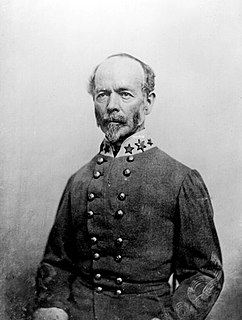
The Army of the Shenandoah was an army of the Confederate States of America during the American Civil War; it was organized to defend the Shenandoah Valley of Virginia in the early months of the war. The army was transferred to reinforce the Confederate Army of the Potomac at the First Battle of Bull Run, which was its only major action. After the battle, the army was merged into the Army of the Potomac.

The U.S. state of West Virginia was formed out of western Virginia and added to the Union as a direct result of the American Civil War, in which it became the only modern state to have declared its independence from the Confederacy. In the summer of 1861, Union troops, which included a number of newly formed Western Virginia regiments, under General George McClellan, drove off Confederate troops under General Robert E. Lee. This essentially freed Unionists in the northwestern counties of Virginia to form a functioning government of their own as a result of the Wheeling Convention. Prior to the admission of West Virginia the government in Wheeling formally claimed jurisdiction over all of Virginia, although from its creation it was firmly committed to the formation of a separate state.

James Dearing was a Confederate States Army officer during the American Civil War who served in the artillery and cavalry. Dearing entered West Point in 1858 and resigned on April 22, 1861, when Virginia seceded from the Union. Dearing was mortally wounded at the Battle of High Bridge during the Appomattox Campaign of 1865, making him one of the last officers to die in the war. Despite serving as a commander of a cavalry brigade and using the grade of brigadier general after he was nominated to that grade by Confederate President Jefferson Davis, Dearing did not officially achieve the grade of brigadier general because the Confederate Senate did not approve his nomination. His actual permanent grade was colonel.
The 2nd Wisconsin Infantry Regiment was an infantry regiment that served in the Union Army during the American Civil War. It spent most of the war as a member of the famous Iron Brigade of the Army of the Potomac. It suffered the largest number of casualties as a percentage of its total enlistment of any Union Army unit in the war.
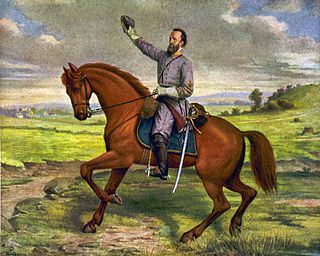
Stonewall Jackson’s military career consists of a combination of various brevet, temporary, and permanent appointments in no less than five different military organizations.

The general officers of the Confederate States Army (CSA) were the senior military leaders of the Confederacy during the American Civil War of 1861–1865. They were often former officers from the United States Army prior to the Civil War, while others were given the rank based on merit or when necessity demanded. Most Confederate generals needed confirmation from the Confederate Congress, much like prospective generals in the modern U.S. armed forces.

Meriwether Lewis Clark was an architect, civil engineer and politician. He was also a military officer in the Mexican–American War and the American Civil War. He was a son of famous explorer William Clark.
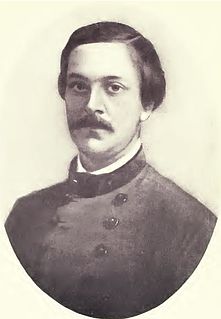
John Thompson Brown was a Confederate States Army colonel and artillerist in the American Civil War. He participated in the first exchange of cannon fire, in fact the first shots fired, between a Confederate force and a Union force in Virginia during the Civil War. Brown's company of the Virginia Richmond Howitzers artillery regiment, with Brown in command according to some sources, and a Union force, the gunboat USS Yankee, had a minor engagement at the Battle of Gloucester Point, Virginia on May 7, 1861. Neither side suffered casualties. Brown is credited by some sources with firing the first shot of the Civil War in Virginia at that first, minor engagement in the state. During the war, he advanced from the rank of first lieutenant to the rank of colonel in charge of a division of artillery in the Army of Northern Virginia. He was killed by a sharpshooter at the Battle of the Wilderness, May 6, 1864.
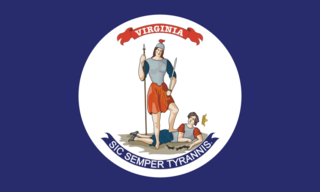
The 12th Virginia Infantry Regiment was an infantry regiment mostly raised in Petersburg, Virginia, for service in the Confederate States Army during the American Civil War, but with units from the cities of Norfolk and Richmond, and Greensville and Brunswick counties in southeastern Virginia. It fought mostly with the Army of Northern Virginia.

Samuel Read Anderson was an American businessman and military officer in the Mexican-American War. He was the Postmaster of Nashville, Tennessee, from 1853 until 1861 and then was a Confederate Brigadier General during the American Civil War. He commanded a mixed brigade of infantry and cavalry in the Eastern Theater in Virginia until the spring of 1862 when he was forced to resign because of ill health. Anderson later supervised the Confederate military draft in Tennessee until the end of the war.
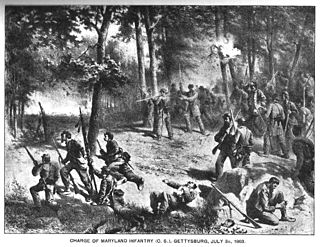
The Maryland Line in the Army of the Confederate States of America was made up of volunteers from Maryland who, despite their home state remaining in the Union, fought for the Confederate States of America during the American Civil War. Of approximately 25,000 Marylanders who volunteered, most fought in the Army of Northern Virginia, and it was not until late in 1863 that a Maryland Line in the CSA was formally created. However, by this late stage in the war, few men wished to leave the units they had fought alongside for more than two years, and the exiles' dream of an independent Maryland Line in the Confederate army would never be fully realized.
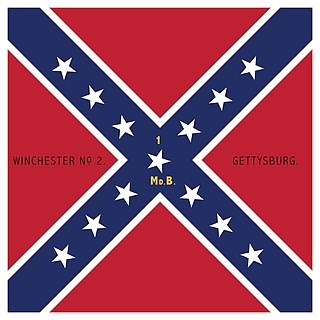
The 2nd Maryland Infantry, CSA, was a Confederate infantry regiment made up of volunteers from Maryland who, despite their home state remaining loyal to the Union during the American Civil War, chose instead to fight for the Confederacy. The regiment was largely made up of volunteers from the 1st Maryland Infantry, CSA, which was disbanded in August 1862, its initial term of duty having expired. They saw action at many of the fiercest battles of the Civil War, taking part in the brutal fighting at Culp's Hill at the Battle of Gettysburg. The unit suffered such severe casualties during the war that, by the time of General Robert E. Lee's surrender at Appomattox Court House on April 9, 1865, only around forty men remained.

The units of the Arkansas Militia in the Civil War to which the current Arkansas National Guard has a connection include the Arkansas State Militia, Home Guard, and State Troop regiments raised by the State of Arkansas. Like most of the United States, Arkansas had an organized militia system before the American Civil War. State law required military service of most male inhabitants of a certain age. Following the War with Mexico, the Arkansas militia experienced a decline, but as sectional frictions between the north and south began to build in the late 1850s the militia experienced a revival. By 1860 the state's militia consisted of 62 regiments divided into eight brigades, which comprised an eastern division and a western division. New regiments were added as the militia organization developed. Additionally, many counties and cities raised uniformed volunteer companies, which drilled more often and were better equipped than the un-uniformed militia. These volunteer companies were instrumental in the seizure of federal installations at Little Rock and Fort Smith, beginning in February 1861.

George Alexander Porterfield was a junior officer of United States forces in the Mexican–American War, colonel, in the Confederate States Army during the first year of the American Civil War and longtime banker in Charles Town, West Virginia, after the war. He was in command of Confederate forces at Philippi in northwestern Virginia, later West Virginia, when they were surprised and routed, though with only a few soldiers wounded or captured, by Union Army forces on June 3, 1861, near the beginning of the Civil War. After serving in staff and temporary field positions for 11 more months, Porterfield resigned from the Confederate Army because he lost his position in a regimental election. In 1871 he helped found a bank at Charles Town, West Virginia, which he served for many years. At his death, he was the third-last surviving veteran officer of the Mexican–American War.
The Adjutant General of Maryland is the head military official of the Maryland National Guard, the Maryland Defense Force, and any other military or paramilitary units that may be maintained by the State of Maryland. The adjutant general is responsible for the military department's budget and maintains all State-owned armories in Maryland.
William Henry Harman was a brigadier general in the Virginia militia and colonel in the Confederate States Army during the American Civil War, who was killed in action during the Battle of Waynesboro, Virginia, on March 2, 1865.
The Provisional Army of Tennessee was activated on May 9, 1861, when Tennessee had entered into a military league with the Confederate States. The provisional army were to contain 25,000 men for field service and 30,000 in the reserves. The staff officers were appointed by the Governor, while the field, company, and non-commissioned officers were elected by the men. It was transferred to the Provisional Army of the Confederate States as of July 31, 1861; the transfer being concluded by August 7, the same year.
References
- ↑ A Guide to the Provisional Army of Virginia
- ↑ "Provisional Army of Virginia Commission Document, 1861". Virginia Military Institute . Retrieved 5 August 2021.
- ↑ Provisional Army of Virginia Commission Document, 1861 July 8, VMI Archives, Preston Library
- ↑ Virginia State Archives, War of the Rebellion, 4th Series, I:484